The U.S. military boasts a remarkable collection of state-of-the-art technology combined with proven hardware.
From firearms to naval vessels, the American armed forces utilize an extensive array of tools to ensure their readiness and global presence.
The Worldwide Equipment Guide (WEG) provides an in-depth look at the military systems, variations, and enhancements U.S. forces may encounter, both currently and in the future.
Curious about what gear a U.S. soldier takes into combat? Or how naval ships are outfitted for different missions? The military equipment guide offers insight into this domain, covering everything from personal gear to large warships.
It’s not just about firepower—communication systems, logistical support, and augmented reality headsets are also vital components of modern warfare.
As technological advancements continue, military equipment evolves in tandem.
For instance, the Next Generation Squad Weapon Program seeks to upgrade various traditional weapons and ammunition with more sophisticated options.
This ongoing innovation ensures U.S. forces remain at the cutting edge of military capability and prepared for any challenge that may emerge.
### Key Takeaways
– The U.S. military employs a diverse selection of weapons and equipment across its various branches.
– Continuous advancements in military technology lead to regular updates of the American arsenal.
– Understanding military equipment is essential for training, strategy, and international military collaboration.
## Structure of the United States Armed Forces
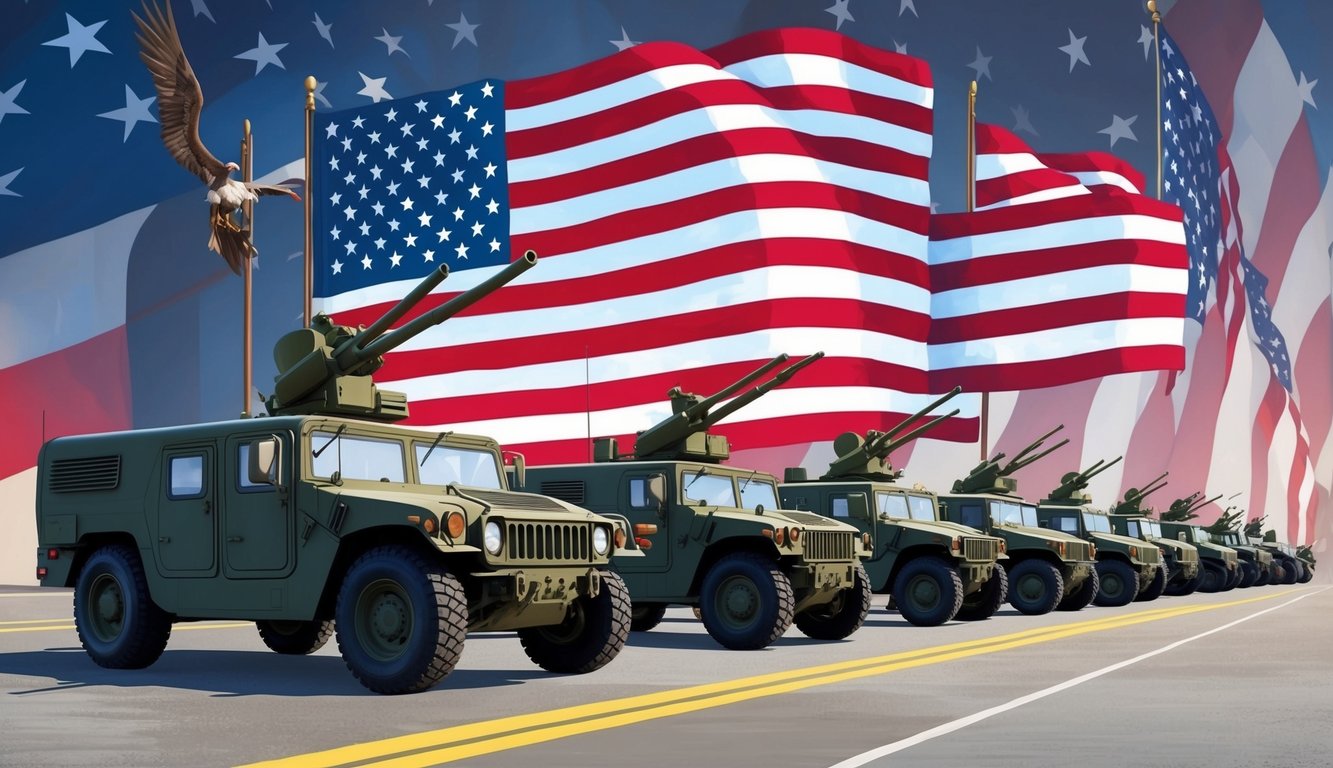
The U.S. military is a multifaceted organization comprised of various branches and specialized units, each with unique roles and capabilities.
### Branch Overview
The U.S. Armed Forces are made up of six primary branches:
– **Army:** The largest and oldest branch, focused on land operations.
– **Navy:** Conducts maritime operations and exerts power across the seas.
– **Air Force:** Specializes in air and space superiority.
– **Marine Corps:** A rapid-response force for amphibious operations.
– **Coast Guard:** Safeguards U.S. waters and enforces maritime law.
– **Space Force:** The newest branch, responsible for space operations and capabilities.
Each branch possesses its distinct culture, equipment, and mission objectives.
While the Army and Marine Corps share some overlap in ground combat, the Navy and Coast Guard operate primarily in maritime contexts.
### Key Military Organizations
The Department of Defense (DoD) manages most military operations, with the Pentagon acting as its main headquarters.
Within the DoD, you’ll find:
– **Joint Chiefs of Staff:** The chief military advisors to the President.
– **Combatant Commands:** Unified commands responsible for specific geographic regions or functional areas.
The National Guard and Reserve components bolster active-duty forces, ready to be called upon for national emergencies or overseas assignments.
Special operations forces, including Navy SEALs and Army Green Berets, undertake high-risk missions across all branches.
Additionally, various support agencies handle tasks such as logistics, intelligence, and medical services.
## Personnel and Military Life
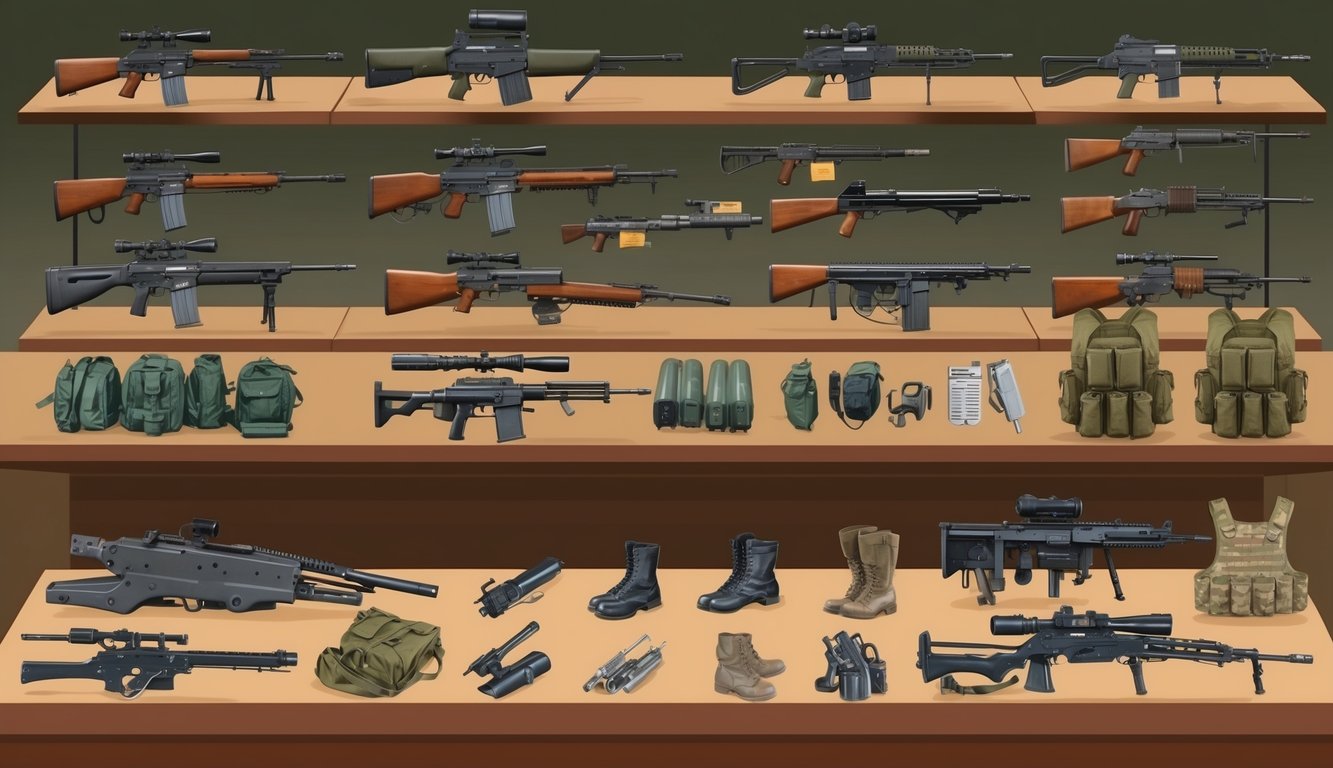
The strength of the U.S. Army lies in its committed personnel and their dedication to service.
The military fosters a structured yet dynamic environment that influences soldiers’ lives from recruitment through deployment.
### Recruitment and Training of Soldiers
When you join the Army, you embark on a path of rigorous training.
Basic Combat Training lasts ten weeks and challenges you physically and mentally.
You’ll acquire vital skills like marksmanship, first aid, and tactical communication.
Following basic training, you will proceed to Advanced Individual Training (AIT), where you focus on your specific Military Occupational Specialty (MOS).
The duration of this training varies based on the role, spanning from weeks to several months.
The Army provides over 150 career options, ranging from combat roles to technical and support positions.
Possible careers include infantryman, cyber operations specialist, or helicopter mechanic.
### Military Uniforms and Attire
Your uniform represents pride and functionality in the Army.
The Operational Camouflage Pattern (OCP) serves as the standard combat uniform, designed for durability and adaptability in various environments.
For formal occasions, soldiers wear the Army Service Uniform (ASU), a sharp blue ensemble featuring a coat, trousers or skirt, white shirt, and black tie or tab.
Physical fitness is paramount, and you’ll often wear the Army Physical Fitness Uniform (APFU), which consists of black shorts, a gray t-shirt, and reflective elements for safety during early morning workouts.
### Daily Life and Deployment
Life in the Army is characterized by routine and readiness.
Typical days start early with physical fitness training, followed by role-specific duties, which may include equipment maintenance, drills, or briefings.
Deployments are integral to military life.
You may be stationed within the U.S. or sent overseas for extended periods.
While deployed, accommodations can range from barracks to field conditions, often requiring long hours of work in demanding surroundings.
Off-duty periods allow for personal interests, with base amenities such as gyms, libraries, and recreation centers available.
Many soldiers utilize educational benefits to earn degrees or certifications while serving.
Support for families is critical; the Army offers resources for spouses and children, including healthcare, childcare, and employment assistance programs to help maintain morale and readiness for both soldiers and their families.
## Land Weaponry and Vehicles
The U.S. military employs a varied range of land-based weapons and vehicles.
From small arms to powerful tanks and artillery, these assets are crucial for ground operations.
Let’s dive into key categories of land military equipment.
### Small Arms and Firearms
The U.S. military arsenal features a wide selection of small arms.
The M4 carbine is the standard-issue rifle for most personnel—lightweight, accurate, and compatible with 5.56mm NATO ammunition.
The M17 and M18 pistols have recently replaced the older M9 as the preferred sidearms.
These 9mm handguns provide improved ergonomics and modularity.
Support weapons like the M249 light machine gun and M240 medium machine gun deliver sustained firepower.
The Army is also rolling out the XM250 as part of a next-generation squad weapon initiative to replace some M4s and M249s.
Specialized units may utilize additional armaments like sniper rifles or grenade launchers, each designed to meet specific tactical requirements.
### Tanks and Ground Vehicles
The M1 Abrams main battle tank serves as the centerpiece of U.S. armored forces.
This formidable 70-ton vehicle is armed with a 120mm main gun, advanced armor, and a turbine engine.
For infantry transport, models like the M2 Bradley Fighting Vehicle and Stryker armored personnel carrier provide a balance of protection, mobility, and firepower.
Light tactical vehicles include:
– Humvees (currently being phased out)
– Joint Light Tactical Vehicles (JLTV)
– Mine-Resistant Ambush Protected (MRAP) vehicles
Each of these vehicles serves a distinct purpose, from reconnaissance to transporting troops and serving as mobile command centers.
### Artillery and Missile Systems
Artillery units are vital for providing fire support to ground troops.
The M109 self-propelled howitzer can fire 155mm shells over distances exceeding 30 kilometers.
For rocket artillery, the M270 MLRS and M142 HIMARS deliver devastating long-range strike capabilities.
Mortars, such as the 60mm M224 and 81mm M252, equip infantry with organic indirect fire options, allowing for quick engagement of targets from protected positions.
In the anti-tank category, Javelin and TOW missile systems can destroy armored vehicles at considerable distances.
Additionally, air defense systems like the Patriot missile battery guard against aerial and ballistic threats, with new technologies being developed to counter evolving drone swarm strategies.
## Air Power: Aircraft and Equipment
The air power of the U.S. military consists of a diverse fleet, including fixed-wing aircraft, rotary-wing platforms, and unmanned aerial systems.
These assets are essential for achieving air superiority, conducting reconnaissance, and supporting operations.
### Fixed-Wing Aircraft
The backbone of U.S. air power includes fighters, bombers, and transport aircraft.
The F-35 Lightning II is a fifth-generation stealth fighter that offers advanced sensors and weapons integration, while the F-22 Raptor excels in air-to-air combat with exceptional maneuverability.
For long-range strike capabilities, the B-2 Spirit serves as a critical asset, capable of penetrating deep into enemy territory undetected.
The C-130 Hercules continues to operate as a versatile transport aircraft, effective even on rough, unprepared runways.
The KC-135 Stratotanker from Boeing provides essential aerial refueling, extending the operational range of other aircraft.
The E-3 Sentry AWACS, also from Boeing, functions as an airborne early warning and control platform.
### Helicopters and Tiltrotor Aircraft
Rotary-wing aircraft play a versatile role in various military operations.
The UH-60 Black Hawk acts as a utility helicopter for troop transport and medical evacuation needs.
For attack missions, the AH-64 Apache is equipped with a formidable arsenal of weapons and sensors.
The V-22 Osprey, developed by Bell Textron and Boeing, combines helicopter vertical takeoff capabilities with turboprop speed and range, facilitating rapid deployment in complex environments.
The Marine Corps utilizes the CH-53K King Stallion, a heavy-lift helicopter designed to transport troops and equipment across extensive distances.
### Unmanned Aerial Vehicles
UAVs (unmanned aerial vehicles) are increasingly vital in modern combat.
The MQ-9 Reaper provides long-endurance intelligence, surveillance, and reconnaissance (ISR) capabilities, as well as the ability to perform precision strikes.
For tactical reconnaissance, the RQ-11 Raven is a small, hand-launched UAV that grants ground units valuable “eyes in the sky” for local situational awareness.
The RQ-4 Global Hawk delivers high-altitude, long-endurance ISR capabilities, with advanced sensors that cover expansive areas, supplying crucial intelligence data to military commanders.
## Naval Forces and Expeditionary Equipment

The U.S. Navy and Marine Corps employ a broad spectrum of ships, vehicles, and equipment to facilitate maritime operations and expeditionary missions.
These resources enable force projection, amphibious assaults, and sea control globally.
### Naval Ships and Submarines
Core components of U.S. naval might include aircraft carriers, destroyers, and submarines.
The fleet contains 11 nuclear-powered aircraft carriers, each capable of launching over 75 aircraft, with Nimitz and Ford-class carriers serving as floating airbases to extend air power worldwide.
Arleigh Burke-class destroyers are the Navy’s primary surface combatants, executing anti-air, anti-submarine, and land assault missions, bolstered by the Aegis combat system’s advanced radar and missile technologies.
Underwater operations rely on Ohio-class submarines for nuclear deterrence with Trident ballistic missiles, while Virginia-class attack submarines excel in hunting adversarial vessels and executing covert missions using sophisticated sonar and torpedo systems.
### Marine Corps Assets
The Marine Corps utilizes a combination of air and land assets for amphibious assaults and expeditionary operations.
The MV-22 Osprey tiltrotor aircraft is fundamental for troop and cargo transport, marrying helicopter versatility with fixed-wing speed.
On land, the Marines employ M1A1 Abrams tanks for firepower alongside Light Armored Vehicles (LAVs) that provide mobility and reconnaissance utility.
Amphibious Assault Vehicles (AAVs) further facilitate transport from ship to shore.
Artillery support is provided by the M777 howitzer for precise strikes and HIMARS rocket systems for long-range firepower, equipping the Marines with the necessary capabilities to seize and hold territory.
### Landing Craft and Amphibious Vehicles
Efficient amphibious operations require effective transportation of troops and equipment ashore.
The Landing Craft Air Cushion (LCAC) hovercraft can swiftly traverse over water and beaches while carrying vehicles and cargo, easily accessing roughly 70% of the world’s coastlines.
Alternatively, Landing Craft Utility (LCU) serves a traditional role in transporting tanks and heavy equipment onto sandy shores, commonly stationed on amphibious assault ships.
The new Amphibious Combat Vehicle (ACV) is set to replace outdated AAVs, swimming from ship to shore while fighting alongside ground troops, offering enhanced protection and mobility tailored for littoral operations.
## Communication and Technology
To maintain an advantage on the battlefield, the U.S. military employs advanced communication systems and cutting-edge technologies.
These systems facilitate seamless coordination, improved situational awareness, and superior command and control capabilities.
### Radio and Satellite Systems
Across military branches, various radio and satellite systems are in operation.
The Joint Tactical Radio System (JTRS) delivers software-defined radios that can access multiple frequencies, enabling interoperability among different units and allied forces.
Satellite communications are critical for long-range operations.
The Advanced Extremely High Frequency (AEHF) satellite system ensures secure, jam-resilient communication for strategic missions, while the Mobile User Objective System (MUOS) offers smartphone-like capabilities to deployed troops.
### Advanced Military Technologies
Beyond radios, numerous high-tech tools bolster military capabilities.
Directed energy weapons, including high-power microwave and laser systems, are under development to neutralize threats like drones and projectiles, providing precise targeting and virtually unlimited ammunition.
In electronic warfare domains, communication jammers assist in disrupting enemy coordination.
The Counter Communications System (CCS) is designed specifically to interfere with adversary satellite communications.
Another innovative tool is the Modular Communications Node-Advanced Enclave (MCN-AE), which enhances secure communication over networks, improving connectivity and data sharing on the battlefield.
## Arms Development and Military Innovation
The U.S. military is continually pursuing advanced weaponry and equipment to secure battlefield dominance.
Ongoing initiatives focus on modernizing existing systems, while research into emerging technologies aims to transform warfare.
### Current Equipment Programs
The Next Generation Squad Weapon (NGSW) program is set to revamp infantry small arms, featuring the XM5 rifle and XM250 automatic rifle to replace the M4 and M249 in the near future.
These new firearms utilize 6.8mm ammunition for improved range and lethality.
Additionally, the Army is developing the Optionally Manned Fighting Vehicle to substitute the Bradley, incorporating advanced sensors, weaponry, and unmanned operational capabilities.
In aviation, the F-35 continues to evolve as a multi-role stealth fighter, with updated electronic warfare pods and munitions enhancing its efficacy.
### Future Warfare Innovations
Hypersonic weapons capable of exceeding Mach 5 speeds are a critical focus, with an expectation to see both air-launched and ground-based hypersonic missiles operational by 2030.
Advancements in directed energy technologies, like lasers and microwaves, are also progressing quickly.
Naval vessels are reportedly testing defensive laser systems to counter swarms of drones and small boats.
Artificial intelligence and autonomous systems are anticipated to play substantial roles in future conflicts.
Developments in robotic combat vehicles, drone swarm technology, and AI-driven decision tools are currently underway.
Quantum technology holds potential for enabling unbreakable communications and improved sensing capabilities, prompting significant investments in quantum research by the military.
## Ordnance and Ammunition
The extensive arsenal of the U.S. military encompasses a variety of ordnance and ammunition essential for maintaining combat effectiveness, including small arms rounds and larger munitions for artillery and explosives.
### Small Caliber Munitions
A wide array of small caliber ammunition types constitutes the U.S. military’s inventory, ranging from 5.56mm cartridges for M4 carbines to 9mm pistol rounds.
Ammo categorized as “small caliber” includes rounds up to 30mm.
Commonly used rifle ammunition is the 5.56x45mm NATO, while pistols typically utilize 9x19mm Parabellum cartridges.
Machine guns predominantly fire 7.62x51mm NATO rounds.
Special forces may deploy subsonic ammunition for stealth missions.
Tracer rounds are valuable for target marking and fire adjustment.
### Heavy Ordnance and Explosives
Heavy ordnance encompasses an array of powerful munitions.
The military employs artillery shells, mortar rounds, and large caliber cannon ammo in this category.
For long-range fire support, 105mm and 155mm howitzer shells are standard.
Mortars ranging from 60mm to 120mm enable infantry indirect fire capabilities.
Explosive ordnance includes items from hand grenades to guided bombs.
The C4 plastic explosive is a common choice for demolitions, while anti-tank munitions like the AT4 fire 84mm rockets intended to neutralize armored threats.
Naval ordnance consists of torpedoes and depth charges designed for underwater combat, while aerial munitions range from unguided bombs to precision-guided missiles.
## Support Services and Logistics
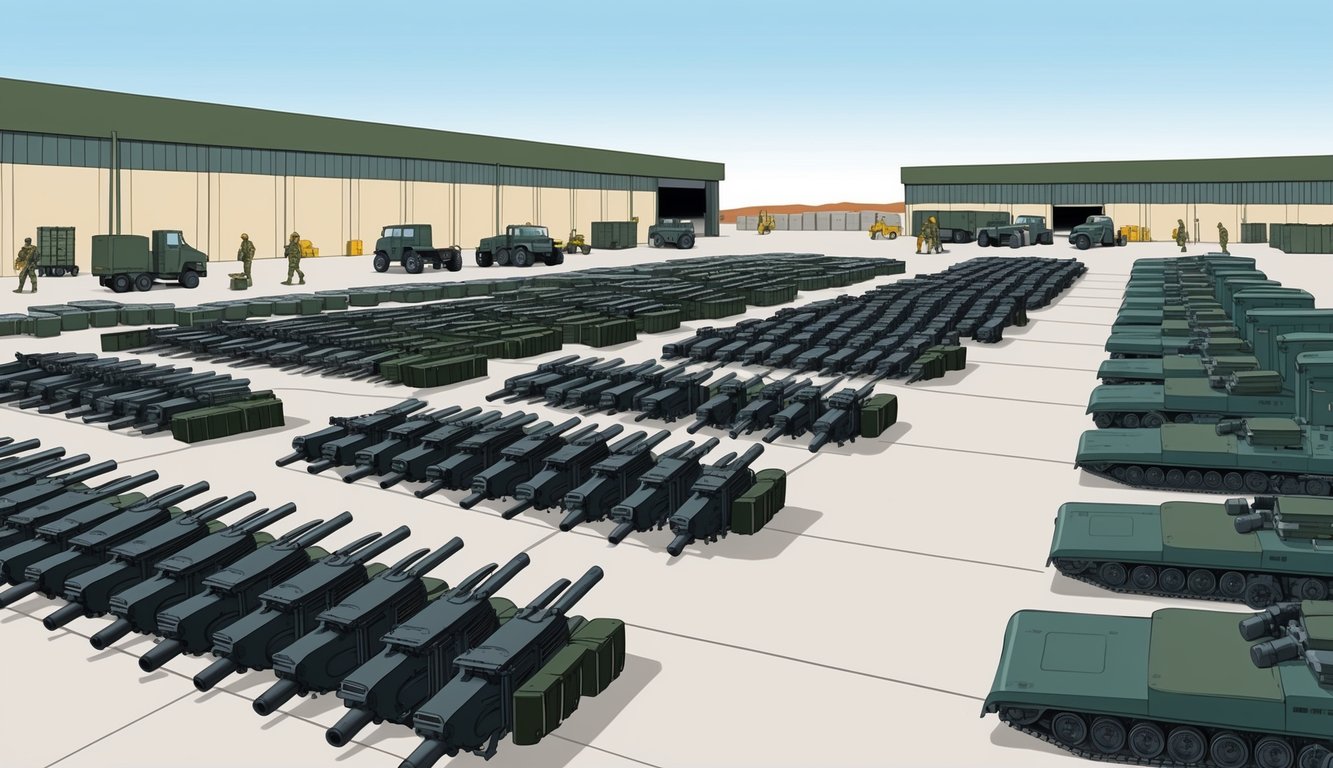
The effectiveness of support services and logistics is vital for ensuring the U.S. military maintains combat readiness and operational efficiency.
These services guarantee that troops receive the necessary resources when needed in the field.
### Maintenance and Field Support
Maintenance and field support are crucial for the operational status of military weapons and equipment.
Units depend on skilled technicians and robust support frameworks to resolve issues and conduct swift repairs.
Mobile repair teams can deploy to forward sites, equipped with specialized tools and components to enable quick fixes, thereby reducing downtime in combat environments.
Preventive maintenance protocols are essential for spotting potential problems early, involving regular inspections, cleaning, and part replacements to keep equipment functioning optimally.
The Army’s Logistics Readiness Centers provide centralized services for significant repairs and overhauls, outfitted with advanced diagnostic tools and a wide array of replacement parts.
### Logistical Readiness and Supply Chains
An effective supply chain is crucial for keeping U.S. forces equipped and operational.
The military employs sophisticated inventory management systems to monitor supplies and anticipate future requirements.
Strategically positioned depots and warehouses ensure critical items are readily available for rapid distribution to units around the globe.
The Defense Logistics Agency coordinates with suppliers to secure a constant flow of parts, ammunition, and essential supplies, utilizing long-term contracts and just-in-time delivery strategies to balance cost with availability.
In combat situations, forward supply bases optimize delivery speeds, with helicopters and tactical vehicles frequently resupplying front-line units.
Oversight for many of these logistics efforts is provided by the Office of the Assistant Secretary of the Army for Acquisition, Logistics, and Technology, which aims to modernize and enhance logistical processes.
## Global Military Presence and Cooperation
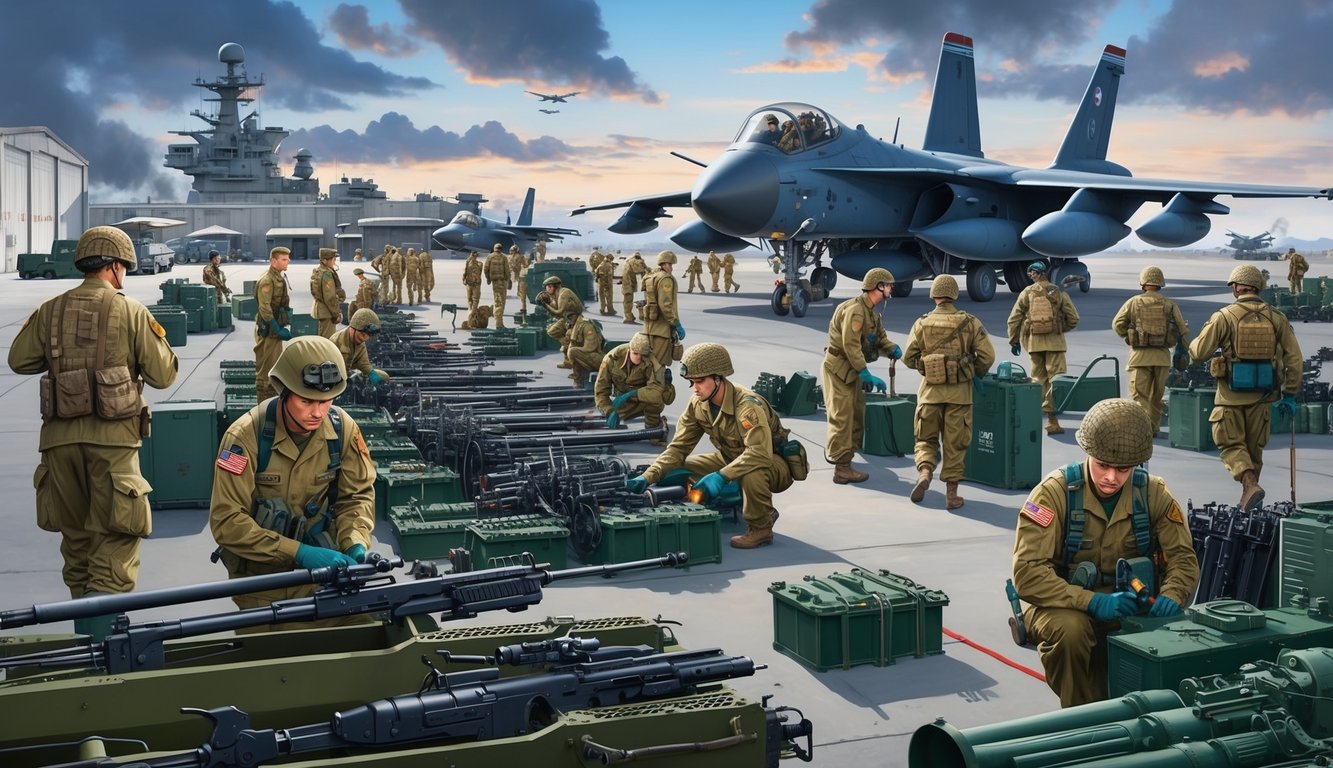
The U.S. military sustains a global presence through international bases and partnerships, enabling rapid responses to threats and bolstering alliances worldwide.
### Allied Forces and Joint Operations
U.S. forces regularly collaborate with allies in joint operations globally, with NATO serving as a prime example where American troops train and deploy jointly with European partners.
In the Pacific, partnerships with Japan and South Korea are critical for regional stability and deterrence of aggression.
Joint exercises, such as RIMPAC in the Pacific and Defender Europe, demonstrate the interoperability of U.S. and allied forces, preparing troops for real-world operations.
### Overseas Operations and Impact
U.S. bases overseas act as strategic centers for local operations, with facilities in Germany supporting missions across Europe and Africa, while bases in Japan and South Korea play vital roles in Asia-Pacific security.
Your tax contributions help to fund humanitarian aid and disaster relief missions carried out by the military.
Following natural disasters, U.S. forces often step in to provide essential care and supplies to affected regions.
In Ukraine, substantial American military support is evident, with U.S. weapons and training assistance significantly enhancing Ukraine’s defense capabilities against Russian aggression.
## Frequently Asked Questions
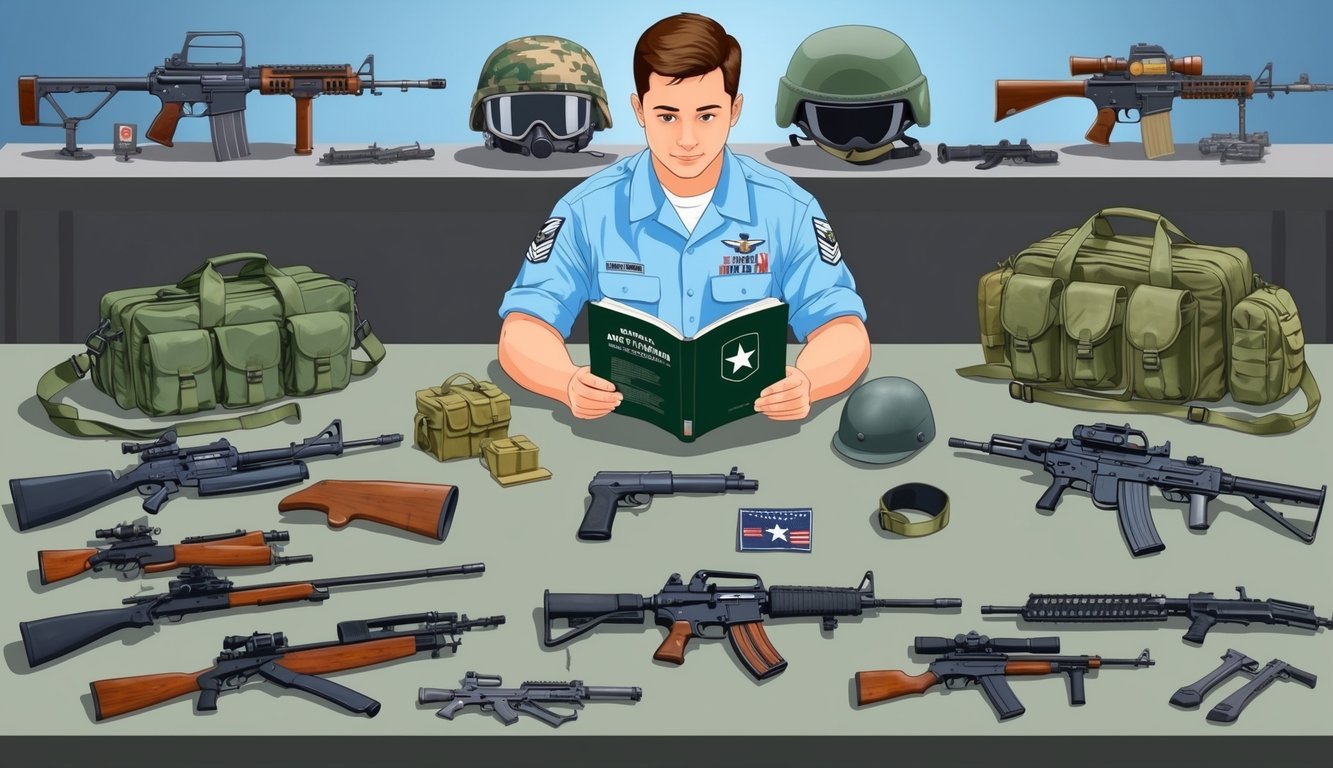
The U.S. military operates a diverse range of weapons and equipment across its branches.
From personal gear to naval assets, troops depend on advanced technology to execute their missions effectively and safely.
### What are the latest advancements in US military weapons and technology?
Recent developments encompass directed energy weapons, hypersonic missiles, and AI-powered systems.
The Army is working on next-generation combat vehicles that promise enhanced protection and lethality.
Innovations in body armor and exoskeletons are aimed at improving soldier safety and operational effectiveness.
### Can you list some standard equipment currently used by the US armed forces?
Standard gear includes the M4 carbine, Beretta M9 pistol, and night vision goggles.
Soldiers are equipped with plate carriers, helmets, and tactical radios.
Vehicles such as the Humvee and MRAP offer both transportation and protection. GPS devices and rugged tablets assist in navigation and communication.
### How many different types of weapons are typically in a US soldier’s arsenal?
A typical U.S. soldier may carry between 3-5 weapons, often including a primary rifle, a sidearm, and grenades.
Depending on their specific role, additional equipment may include light machine guns or rocket launchers.
Specialized weapons are available for particular missions or units.
### What are some of the most powerful weapons in the US military’s possession?
The most formidable weapons in the U.S. arsenal include nuclear warheads and intercontinental ballistic missiles.
Aircraft carriers, stealth bombers, and guided missile destroyers provide significant firepower capacity.
Additionally, the GBU-43/B MOAB (Massive Ordnance Air Blast) is the largest non-nuclear bomb.
### Could you provide an overview of the weapons systems utilized by the US Navy?
The U.S. Navy capitalizes on a wide array of weaponry systems, including surface ships equipped with Aegis combat systems, Tomahawk cruise missiles, and various gun mounts.
Submarines deploy torpedoes and ballistic missiles, while aircraft such as the F/A-18 Super Hornet offer strike and air support capabilities.
### What sorts of personal equipment do service members carry on the battlefield?
Service members carry an assortment of personal equipment, including body armor, helmets, and first aid kits.
Communication gear, hydration systems, and rations are critical components for operations.
Night vision goggles, binoculars, and multi-tools are supportive in different mission contexts.
Protective gear against chemical and biological threats is also provided when required.

